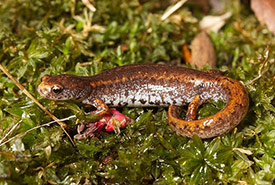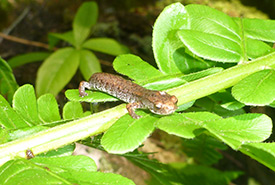
Four-toed salamander (Photo by Brian Gratwicke)
Four-toed salamander
The four-toed salamander is native to eastern North America. It has no lungs; instead it breathes through its skin and the roof of its mouth. It feeds on small invertebrates — spiders, worm, beetles — and other insects.
Salamanders play an important role in forest ecosystems, as they contribute to nutrient cycling and energy flow. Because of their diet, which is rich in calcium, they are nutritious meals for small carnivores.
Description
This reddish-brown salamander has grey sides and a white belly with black speckles. Including the tail, it can grow up to 10 centimetres long. Four-toed salamanders usually have brighter tails than backs, and there is a distinctive constriction at the junction of the body and the tail.
Females and males of this species are distinguishable by a few characteristics. Males are generally smaller with longer tails. They also have elongated, square snouts, while females have short, round snouts.

Four-Toed Salamander (Photo by Nicolas Wampach)
Four-toed salamanders are the only terrestrial salamanders with four toes on their hind feet. They can sometimes be mistaken for eastern red-backed salamanders, who appear similar except without the constriction at the tail, five posterior digits and a slightly different coloured belly (“salt and pepper” instead of white with black). They can also be confused with the northern two-lined salamander, which has two dark brown lines on either side of a lighter band down the length of its back.
Self-defence
These salamanders have three forms of self-defence against potential predators. The first method is to shed their tails as a distraction. While the tail continues to writhe, the salamander is able to flee. The second is to play dead. The third method is to curl up in a ball with its tail on its back. Since the tail is lighter-coloured than the back, this attracts the predator. Because tails are capable of regenerating the salamander is able to escape with its life.
Habitat
Four-toed salamanders can be located in Canada in southern Ontario, southwestern Quebec, Nova Scotia, and in Fundy National Park in New Brunswick. They are the least common salamander in Nova Scotia but are found on both the mainland and Cape Breton Island. This species is also the only white-bellied salamander in the province.
These amphibians live in bogs, boggy streams and flood plains in woodland areas. Adults prefer hardwood forests, while larvae live in water pools.
The species requires both wetland and woodland habitats, so the protection of both is necessary to ensure their survival. During the summer, the species lives in mossy forests and requires sphagnum bogs for reproduction. During the winter they burrow underground, sometimes in groups and occasionally with other amphibians such as eastern red-backed salamanders.
Conservation status
Although four-toed salamanders are not considered at risk in Canada, they are listed as an at risk species in the province of Quebec.
Threats to this species are habitat loss, habitat fragmentation, predation and road mortality.





